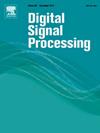Spatial pilot reassignment algorithm for channel estimation stage of cell-free multi-ARS communication systems
IF 2.9
3区 工程技术
Q2 ENGINEERING, ELECTRICAL & ELECTRONIC
引用次数: 0
Abstract
In this paper, we investigate the user throughputs of a Cell-Free (CF) system with multiple aerial relay stations (ARSs), where each ARS is defined as an unmanned aerial vehicle (UAV)-mounted relay station. The system operates under a decode-and-forward (DF) protocol and facilitates connectivity between a terrestrial base station (TBS) and terrestrial users. ARSs are equipped with multiple antennas and simultaneously serve users that are outfitted with single antennas and distributed in a specific area. Additionally, a small-cell (SC) system based on the CF structure, where each ARS serves one user with the best channel conditions, is also considered. We analyze system communication in two stages, including user-ARS links and ARS-TBS links, and then we derive expressions for the data rate of users and ARSs. Moreover, we propose the spatial pilot reassignment (SPR) algorithm to optimize pilot assignment, enhancing channel estimation over random pilot assignment methods. The user throughput is evaluated by altering several system parameters, including the with/without data power control, the number of users, the number of ARSs, and the time interval allocated for channel estimation. The results show that the SPR algorithm improves throughput by about 10% compared to the random pilot assignment method at a 90%-likely user throughput, which is equal to a cumulative distribution function value of 0.1.
无小区多ARS通信系统信道估计阶段的空间先导重分配算法
本文研究了带有多个空中中继站(ARS)的无蜂窝(CF)系统的用户吞吐量,其中每个 ARS 被定义为无人机(UAV)安装的中继站。该系统根据解码转发(DF)协议运行,促进地面基站(TBS)与地面用户之间的连接。中继站配备多根天线,同时为配备单根天线并分布在特定区域的用户提供服务。此外,我们还考虑了基于 CF 结构的小蜂窝(SC)系统,即每个 ARS 在最佳信道条件下为一个用户提供服务。我们分两个阶段分析系统通信,包括用户-ARS 链路和 ARS-TBS 链路,然后推导出用户和 ARS 的数据速率表达式。此外,我们还提出了优化先导分配的空间先导重分配(SPR)算法,与随机先导分配方法相比,该算法增强了信道估计能力。通过改变几个系统参数,包括有/无数据功率控制、用户数量、ARS 数量以及分配给信道估计的时间间隔,对用户吞吐量进行了评估。结果表明,在 90% 的用户吞吐量(相当于累积分布函数值 0.1)时,SPR 算法比随机先导分配方法提高了约 10% 的吞吐量。
本文章由计算机程序翻译,如有差异,请以英文原文为准。
求助全文
约1分钟内获得全文
求助全文
来源期刊

Digital Signal Processing
工程技术-工程:电子与电气
CiteScore
5.30
自引率
17.20%
发文量
435
审稿时长
66 days
期刊介绍:
Digital Signal Processing: A Review Journal is one of the oldest and most established journals in the field of signal processing yet it aims to be the most innovative. The Journal invites top quality research articles at the frontiers of research in all aspects of signal processing. Our objective is to provide a platform for the publication of ground-breaking research in signal processing with both academic and industrial appeal.
The journal has a special emphasis on statistical signal processing methodology such as Bayesian signal processing, and encourages articles on emerging applications of signal processing such as:
• big data• machine learning• internet of things• information security• systems biology and computational biology,• financial time series analysis,• autonomous vehicles,• quantum computing,• neuromorphic engineering,• human-computer interaction and intelligent user interfaces,• environmental signal processing,• geophysical signal processing including seismic signal processing,• chemioinformatics and bioinformatics,• audio, visual and performance arts,• disaster management and prevention,• renewable energy,
 求助内容:
求助内容: 应助结果提醒方式:
应助结果提醒方式:


